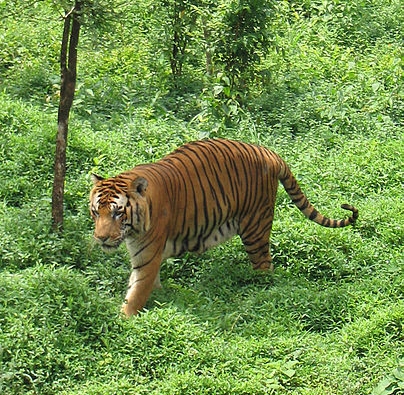By Jeremy Hance / Mongabay
Burning coal fuels climate change, causes acid rain, and spreads toxic pollutants into the environment, but now a new Greenpeace report warns that coal may also imperil the world’s biggest feline: the tiger. Home to world’s largest population of tigers—in this case the Bengal subspecies (Panthera tigris tigris)—India is also the world’s third largest coal producer. The country’s rapacious pursuit of coal—it has nearly doubled production since 2007—has pushed the industry into tiger territory, threatening to destroy forests and fragment the tiger’s already threatened population.
“Unfortunately for the tiger, its largest contiguous habitat—Central India—is also where most of India’s coal lies,” Ashish Fernandes, author of the report, told mongabay.com.
India is one of the bright spots in the global effort to save the tiger from extinction. The country now holds around 1,700 tigers, over half of the world’s population of wild tigers. Although India’s tiger population is generally considered to be in decline, there have been some local population increases giving hope that the country can turn around the situation. Yet the tiger still faces poaching and habitat loss, the latter which is likely to be exacerbated by open pit mining for coal.
Analyzes 13 Central Indian coal mines, in various stages of exploitation, the report finds that full open pit mining in these areas would destroy over a million hectares of forest. According to official data, 18 percent of these forests are known to be used by tigers, 27 percent by leopards, and 5.5 percent by elephants. In all, eight of India’s renowned Tiger Reserves will be impacted, potentially harming around 230 tigers or 13 percent of India’s total tiger population.
“India’s Protected Areas/Tiger Reserves are small by global standards, with few larger than 500 square kilometers. As such, if isolated, their tiger populations are not viable in the long term,” Fernandes explains. “Tigers, males in particular, roam large areas in search of mates, and this ensures genetic vibrancy. As young tigers mature, they also need to establish their own territories, or face conflict with dominant males. Corridors help aid this dispersal and ensure a healthy gene flow between different ‘source’ tiger populations.”
India is a signatory of an ambitious conservation plan to double wild tiger populations worldwide by 2022, a plan which was endorsed by all 13 tiger countries in 2010. Worldwide, tigers have been decimated by habitat loss, prey depletion, and hunting, now largely to feed the Chinese medicine trade. The great cats have been left with about 7 percent of their historical range, and already three subspecies have vanished for good.

